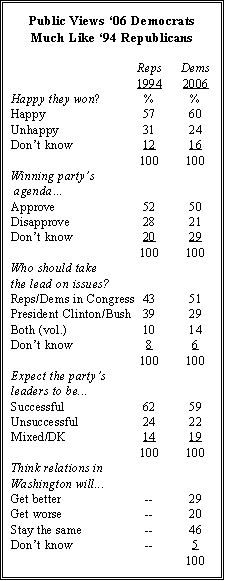
The Democrats’ big win on Nov. 7 has gotten a highly favorable response from the public. In fact, initial reactions to the Democratic victory are as positive as they were to the GOP’s electoral sweep of Congress a dozen years ago. Six-in-ten Americans say they are happy that the Democratic Party won control of Congress; in December 1994, roughly the same percentage (57%) expressed a positive opinion of the GOP’s takeover.
Half of Americans approve of the Democrats’ plans and policies for the future, which also is comparable to approval of the GOP’s proposed agenda in 1994. However, there is one important area where the parallels to 1994 do not hold: By 51%-29%, more Americans want Democratic leaders rather than President Bush to take the lead in solving the nation’s problems. Twelve years ago, the public was divided over whether GOP congressional leaders (43%), or President Clinton (39%), should take the lead in addressing national problems.
The latest national survey by the Pew Research Center for the People & the Press conducted Nov. 9-12 among 1,479 Americans finds that Americans are optimistic that Democrats will actually get their proposals enacted. Roughly six-in-ten (59%) say Democratic leaders will be successful in getting their programs passed into law; again, this is on par with the confidence that Americans voiced about GOP legislative prospects in December 1994.
However, in the wake of a bitter midterm campaign, the public is dubious that the election will lead to increased bipartisanship on Capitol Hill. Just 29% think that relations between Republicans and Democrats will get better in the year ahead; 46% expect relations to remain the same; and 20% predict relations will get worse.
<!–

In this regard, Democrats are cool to the idea of their leaders cooperating with President Bush. About half of Democrats (51%) say party leaders should “stand up” to Bush on important issues, even if that means less gets done in Washington; 42% believe Democratic leaders should try to work with Bush, even if it means disappointing some Democratic supporters. By contrast, most Republicans (61%) want their party’s leaders to try to work with Democratic leaders, while 30% believe GOP leaders should stand up to the Democrats.
Bush’s own job approval ratings have hit a new low in the aftermath of the elections. Just 32% of Americans approve of Bush’s job performance compared with 58% who disapprove. Bush’s job rating stands at just 24% among political independents, who proved crucial to the Democrats’ victory on Nov. 7. By 57%-39%, independent voters cast ballots for Democratic candidates, according to national exit polls. Two years ago, independent voters were more divided (50% Democrat/46% Republican). See “Centrists Deliver for Democrats,” November 8, 2006).

The broad opposition to President Bush among independents is reflected in their strong preference that Democratic leaders, rather than the president, take the lead in solving the nation’s problems. By more than two-to-one (53%-25%), independents believe that Democratic leaders should take the lead on issues. In the aftermath of the 1994 elections, independents like the public generally were divided over whether President Clinton or Republican leaders should have a leading role in dealing with issues.
The survey finds that public perceptions of the situation of Iraq have gone from bad to worse. Overall, 64% feel that the U.S. military effort in Iraq is not going well, up from 59% last month and the highest percentage since the war began. In terms of specific evaluations of the situation, increasing numbers say the U.S. is losing ground in training Iraqi security forces (up 11 points since August), reducing civilian casualties (nine points), and preventing terrorists from establishing a base in Iraq (nine points).–>